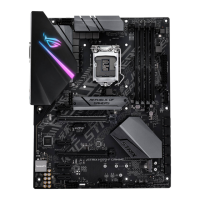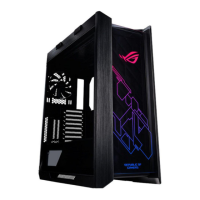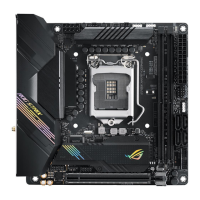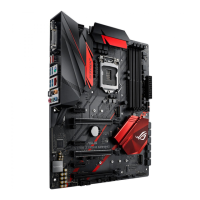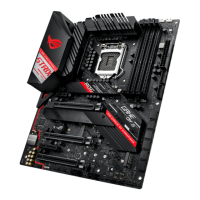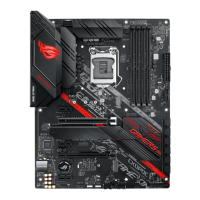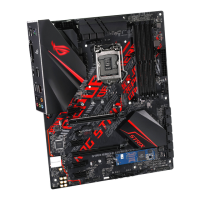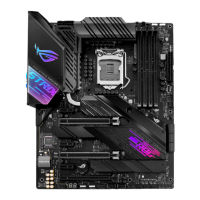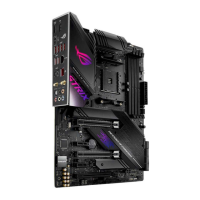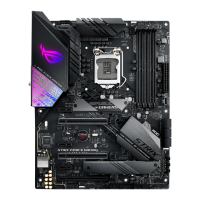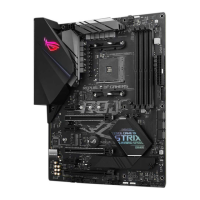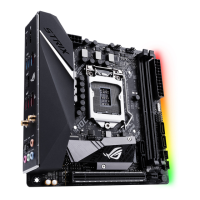
Do you have a question about the Asus Rog Strix H370-I Gaming and is the answer not in the manual?
| Form Factor | Mini-ITX |
|---|---|
| Socket | LGA 1151 |
| Chipset | Intel H370 |
| Memory Slots | 2 |
| Memory Type | DDR4 |
| Max Memory | 32 GB |
| PCIe Slots | 1 x PCIe 3.0 x16 |
| Storage Interfaces | 6 x SATA 6 Gb/s |
| Memory Speed | 2666MHz |
| USB Ports | 4 x USB 3.1 Gen 1, 2 x USB 3.1 Gen 2 |
| Networking | Intel I219-V Gigabit LAN |
| Bluetooth | Bluetooth 5.0 |
| M.2 Slots | 1 x M.2 Socket 3, with M key, type 2242/2260/2280 storage devices support (SATA & PCIE 3.0 x4 mode) |
| Audio Codec | Realtek ALC1220A |
Regulatory statements, including FCC compliance and warnings.
Contact details for ASUS technical support in different regions.
Precautions for preventing electrical hazards during system handling and operation.
General safety guidelines for handling and operating the motherboard and system.
Explains the structure and organization of the user guide.
Lists resources for additional product and software updates.
Explains typographical conventions and symbols used in the manual.
Specifications related to the CPU and socket compatibility.
Details about the motherboard's chipset.
Specifications for system memory (DIMM slots, type, capacity).
Information on PCIe slots for expansion cards.
Specifications for integrated graphics and video output capabilities.
Details on M.2 and SATA storage device support.
Specifications for the onboard LAN controller and connectivity.
Specifications for Wi-Fi and Bluetooth connectivity features.
Specifications for the onboard audio CODEC and features.
Details on USB ports and their specifications and capabilities.
Lists and describes all rear panel input/output ports.
Details on various internal connectors and headers on the motherboard.
Special features exclusive to the Republic of Gamers (ROG) series.
Unique features and technologies provided by ASUS for enhanced performance.
Key features and capabilities of the motherboard's BIOS setup program.
Features related to system manageability and remote access.
Lists the software and drivers included on the support DVD.
Lists the operating systems compatible with the motherboard.
Specifies the physical dimensions and form factor of the motherboard.
Lists the included motherboard model name.
Lists all included cables for system connections.
Lists additional accessories provided with the motherboard package.
Mentions the included ROG motherboard support DVD.
Lists the included user guide.
Identifies the PC chassis as a necessary component for building the system.
Specifies the required CPU fan for the LGA1151 socket.
Lists a common tool required for system assembly and installation.
Identifies DIMM modules as necessary components for memory installation.
Specifies the power supply unit as a critical component for system operation.
Mentions an optional component for disc drives.
Identifies the graphics card as a component for display output.
General overview of the motherboard and its layout.
Safety precautions before installing motherboard components.
Diagram and identification of motherboard connectors and components.
Information about the CPU socket and compatibility.
Details on DDR4 DIMM slots and memory configurations.
Information on PCIe slots for expansion cards.
Function and usage of motherboard jumpers and headers.
Description of POST State LEDs and RGB LED lighting.
Details on internal connectors like SATA, USB, and headers.
Guides users through building a PC system with the motherboard.
Step-by-step instructions for installing the motherboard into the chassis.
Detailed steps for correctly installing the CPU into the motherboard socket.
Instructions for installing CPU heatsinks, fan assemblies, and AIO coolers.
Guides on installing and removing memory modules (DIMMs).
Explains how to connect ATX power supply plugs.
Instructions for connecting SATA hard disk drives and SSDs.
Details on connecting front panel connectors (USB, audio, power).
Steps for installing expansion cards into PCIe slots.
Guide on installing M.2 SSD modules into the M.2 sockets.
Instructions for connecting the dual-band Wi-Fi antennas.
Overview of rear panel I/O ports and audio connection types.
Identification and description of all rear panel connectors.
Explains how to connect headphones, microphones, and speaker systems.
Procedures for powering on the system for the first time.
Instructions on how to properly turn off the computer.
Introduction to the ASUS UEFI BIOS interface and concepts.
How to enter and navigate the BIOS setup utility.
Overview of the EZ Mode interface for basic system settings.
Comprehensive explanation of the Advanced Mode for BIOS settings.
How to configure fan profiles and adjust fan speeds.
Tool for overclocking and configuring RAID settings.
Customizing the BIOS interface by saving favorite settings.
Overview of basic system info, date, time, language, security.
Settings for overclocking-related items, CPU, and DRAM.
Advanced system configuration options for CPU, storage, devices.
Displays system temperature, power status, and fan settings.
Options for configuring boot order, fast boot, and CSM.
Access to special functions like BIOS flashing and Secure Erase.
Options to load defaults, save/discard changes, or launch EFI Shell.
Procedures and warnings for updating the motherboard BIOS.
Updating BIOS via Windows environment using EZ Update.
Updating BIOS using USB flash drive or Internet.
Utility for recovering the BIOS from corruption.
